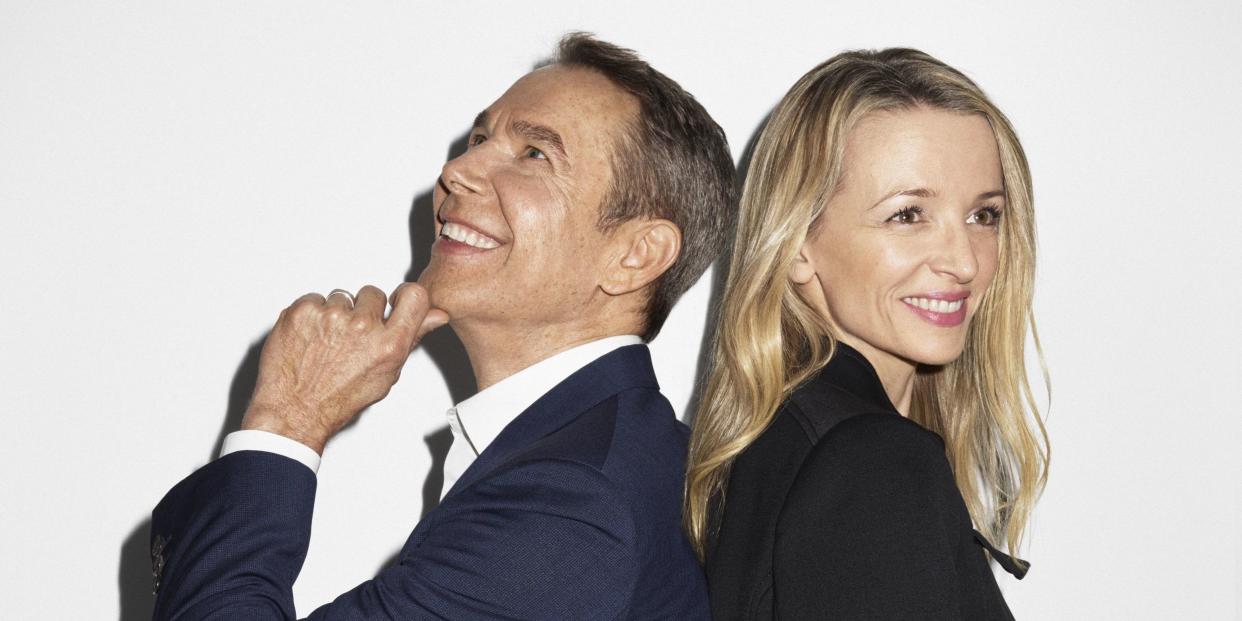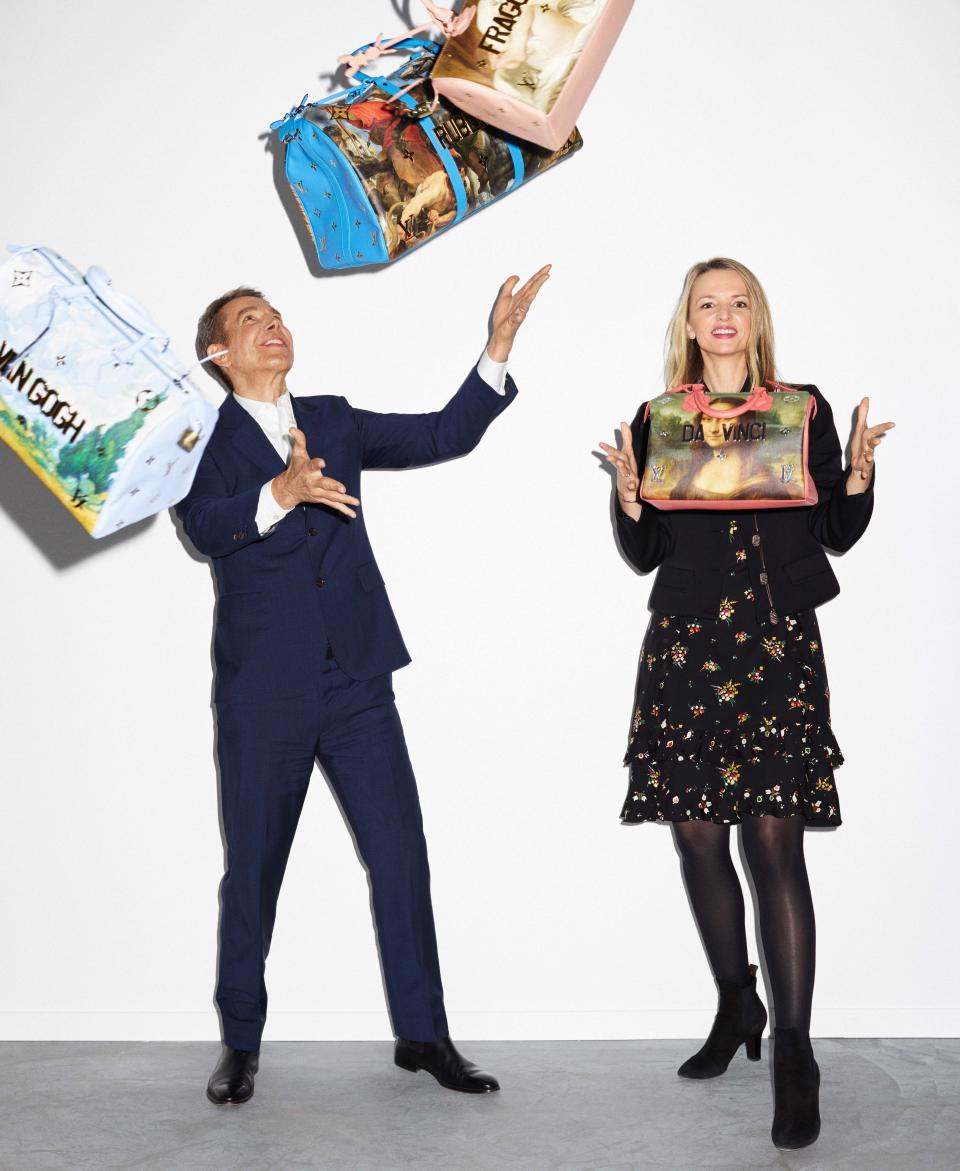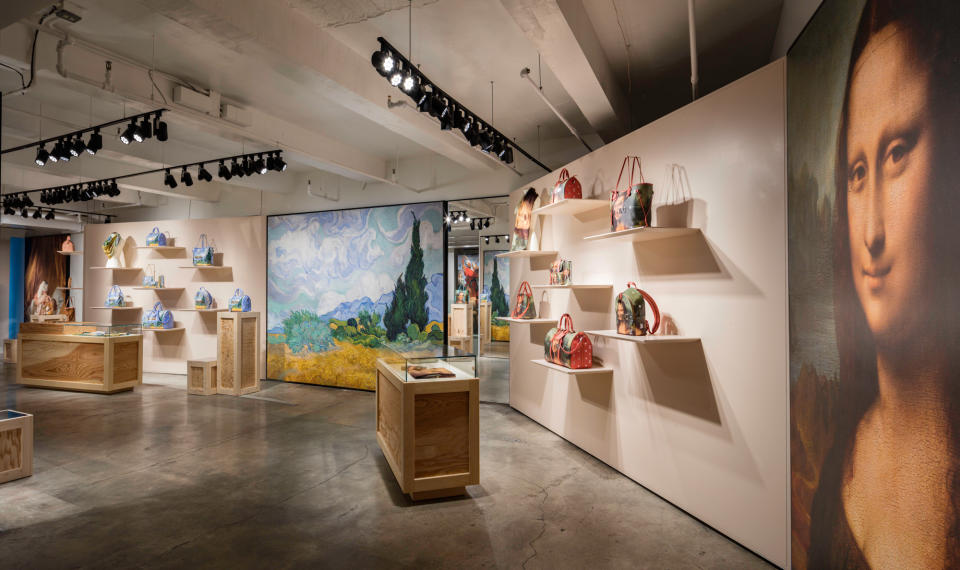Jeff Koons Discusses the Old World Inspiration for His New Project with Louis Vuitton

At a new pop up shop set to open tomorrow, art phenom Jeff Koons unveils his much-talked about, old-masters splashed range of bags for Louis Vuitton-starring none other than Da Vinci, Fragonard, Rubens, and Van Gogh! Collectors, grab these oldies while they're hot.
This article originally appeared in the June 2017 issue of ELLE.
On March 7, the same day one French fashion house mock-launched a branded rocket 33 feet into the air at the Grand Palais, and a beloved Italian brand upholstered practically every inch of the Palais d'Iéna in what appeared to be the faux-fur hide of a Purple People Eater, it was Louis Vuitton that really took Paris's show-location cake-er, macaron. The monumental, Louis XIV–commissioned white-marble warriors of the Louvre museum's cavernous Cour Marly-illuminated by shifting evening light through an I.M. Pei glass pyramid and, one imagines, vibrating gently to the thudding bass of Frank Ocean-bore little evident connection to Nicolas Ghesquière's patterned-fur jackets, high-shine tweed dresses, and cropped flares. Yet the message in staking out an entire wing of the planet's most-visited and arguably most-revered museum? It was a show of force by fashion's most powerful luxury brand.
Two days later, in an unmarked building not far from the museum, Louis Vuitton Executive Vice President Delphine Arnault arrived to unveil another show of force-this one a years-long mission that has, until now, been guarded like a palace secret. As the daughter of Bernard Arnault, head of LVMH-parent company of Vuitton, Dior, Céline, Givenchy, Bulgari, Dom Pérignon, and more-and France's richest man, Delphine, 42, is, along with her brother Antoine (the CEO of men's footwear label Berluti), an heir apparent to the biggest luxury stable in the world. But with her pale blond hair, delicate features, and soft-spoken presence, Delphine is anything but showy about her considerable might; she rarely speaks to the press and, in the interviews she does grant, chooses her words with care and hesitates to take credit for big ideas like, say, the LVMH prize recognizing emerging designers, a project she introduced in 2013 that has become a famously successful incubator for next-generation fashion talent. Yet behind the scenes, Delphine Arnault's ambitions are clearly bold-for, carrying on the brand's grand tradition of artist collaborations, her latest undertaking is turning over LV's bread-and-butter leather goods to Jeff Koons, an artist whose own catalog blurb once described him as waging a "one-man war on taste." The Arnaults are longtime Koons boosters and collectors, and Delphine is something of a megafan. "He is probably the most important living artist," she raves. "I've been to three of his retrospectives-at the Whitney, the Centre Pompidou, the Guggenheim Bilbao." Enlisting Koons, she says, "was a dream."
For art's captain of "obvious," whose oeuvre-from shiny, mammoth balloon animals to a golden sculpture of Michael Jackson and his pet chimp, Bubbles-is in some ways as conceptually accessible as tulips in a deli stall, making luxury goods seems a natural extension of making epic art out of humble objects. In 2006, Koons replicated his shiny Rabbit (based on a blow-up toy) on pendants for Stella McCartney's runway. In 2014, he loaned H&M a six-inch image of his monumental Balloon Dog-a version of the work that sold at Christie's in 2013 for $58.4 million, the highest-ever price at auction for the work of a living artist-for a bag that cost $49.50.
It took some 50 tries for LV artisans to reproduce each painting to Koons's specifications.
But this time around, Koons isn't relying on his own archive. "I think Vuitton is about audacity and innovation," Arnault says. "And brands have to make people think and question." So when Koons said he wanted to make bags (and wallets, computer cases, scarves, key chains-51 items in all) splashed with five of the most iconic works in the art history canon-even Mona Lisa, the most famous painting in the world, says Arnault, who happens to share the Mona Lisa's enigmatic smile-"We thought, Wow, what a genius." In the end result-available live and in person for the first time at Masters – A collaboration with Jeff Koons, a pop up shop at 655 Madison Avenue running tomorrow through July-Fragonard's pearly-skinned girl frolics in bed with her floppy-eared dog across a wallet; Titian's nude Venus, her hand entwined in Mars's hair as Cupid takes his aim, lounges on LV's Neverfull tote; Van Gogh's blue sky undulates over A Wheatfield With Cypresses on a piece of hand luggage. For the pop up, these legendary works are also blown up across double-height LED screens for Manhattan's ritziest residents to marvel at. It's certainly the starriest opening these works have seen in awhile.

For an artist who considers it a moral imperative to polish to perfection even the underside of a 150-ton sculpture-a surface likely to be seen only by professional art movers-the bags, too, are considered from every angle. It took some 50 tries for LV artisans to reproduce each painting to Koons's specifications, showing every brushstroke and nuance of age. Another challenge: devising a finish sufficiently shiny for the bags' many gold LV logos and four-point fleur-de-lis. Then there's the interior. If you unzip, say, the Speedy top-handle, you get a pair of Wiki-style blurbs, one about the great master behind the borrowed work, one about Koons himself. Koons didn't stop there. On each bag (and, thus, each masterpiece), you'll find his own shiny signature as well as his initials, JK, winkingly styled to look like the LV logo.
In New York, sitting in his Chelsea HQ in the middle of an all-white, cathedral-quiet office, surrounded by a handful of the 140 people he employs to manage his business and produce his works, Koons elegantly skirts any suggestion of artistic button-pushing. Instead, he dives into a discourse that ranges from Platonism to humanism to metaphysics and, ultimately, transcendence. It starts with the name that sits smack in the middle of each bag, identifying its old- master creator in big, block-lettered hardware. That's not just an homage. In Paris, Arnault pointed out the letters as a hat-tip to the bags' artistic predecessors, Koons's recent Gazing Ball series, in which he has reproduced 35-plus masterpiece paintings-including the five used here-and affixed to each a reflective blue ball not unlike those most banal of lawn ornaments. Like the supershiny surfaces of many of Koons's most famous pieces, the balls reflect light, but also the viewer. "As soon as you move, it starts," the artist says. "It lets you know that the art is not in the object, but inside you." So on a laptop case in which the Mona Lisa peeks placidly out from behind a smattering of golden logos, those letters-DA VINCI-reflect the person opposite the bag. "All of a sudden, the viewer, the person carrying these bags, are interconnected," Koons says, to the infinite line of art history.
"I realized the power of art that so effortlessly connects all of the human disciplines together: that I can be involved in philosophy and psychology and physics and theology and aesthetics."
He asks an assistant to pull up an image of Diamond (1994–2005), his giant, blingy "stones" cut for the finger of a comic-book giantess. Those sculptures marked the origins of his interest in metaphysics: "As far back as you can go to the point of the diamond, that's as far back as you can go in human history in our biology, in our genes, in our DNA."
Likewise, Koons links backward and forward along strands of cultural interconnectivity: Da Vinci, he says, loved and referenced his fellow Renaissance man, painter Piero della Francesca. "Through being interested in people outside himself, things outside himself, he was able to experience transcendence. This type of linkage changed Da Vinci." Koons, too, claims to have been genetically altered by the work of other artists. "My first art history lesson, my teacher showed us Manet's Olympia, and spoke about what different references it may have had, what types of symbolism, how it may have functioned in nineteenth-century France, people observing the work." He continues, simply: "My life changed. And I became a different human being. All of a sudden, I realized the power of art that so effortlessly connects all of the human disciplines together: that I can be involved in philosophy and psychology and physics and theology and aesthetics." The bags he sees as a symbol of humanism; a person carrying them would, in his eyes, be a person who "enjoys people, enjoys becoming, enjoys the contributions of what people have made before them."

Koons and Vuitton worked closely with the museums that are home to each of the works-largely to get access to the originals and as a courtesy, since works from the distant past are now in the public domain and thus fair game. As director of the Museum of Fine Arts of Rennes in northwestern France, Anne Dary is the current keeper of Peter Paul Rubens's 1616 Tiger Hunt, another of Koons's chosen works. The painting of men on horseback locked in brutal battle with a trio of leaping, majestic beasts illustrates Koons's point about cultural interconnectedness, in that it kick-started an interest in exotic hunting scenes that lasted up to the eighteenth century. "No artist would have produced a hunting scene without Rubens in mind," Dary says. It also inspired 21 known copies, and Rubens himself allowed the work to be painted into Jan Brueghel the Elder's Sight and Smell, in which dozens of lush paintings crowd a collector's wall. Yet, other than postcards and the like, Tiger Hunt has never been reproduced commercially-and certainly never on a $3,200 backpack. Dary says she's constitutionally opposed to the use of art on "goodies-even in museum shops. I just can't stand it!" The difference for her, she says, is that this request came not from a brand, but from an artist. "In my view, an artist can use other artists' works to create their own art," Dary says. Besides, with the royalties from the LV project, her museum will be able to purchase new works of art.
Before leaving Paris, I circled back to the Louvre, compelled to pay homage to the Mona Lisa herself, independent of her gilded accoutrements. It's not hard to find her: You just follow the signs bearing her face. I I recalled my first trip down these infinite marble halls. As a 17-year-old who thought she loved art, I felt vaguely embarrassed that Mona Lisa was one of few works I knew well enough to seek out-already aware of her as both treasure and, perhaps, cliché-and then a little deflated by the reality of her: a mere 30-by-20-inch canvas, protected behind glass, with crowds of schoolchildren held at bay by a wide, semicircular wooden barricade.
This time, I think I can see her a little better. She, who has seen so many generations pass through these halls, looks so wise, so serene, as if to say, You will come and go, and I will still be here. Maybe it's a kind of transcendence.
When I left, I exited through the gift shop, of course. There was Mona Lisa again, so many of her this time-on nail files and notebooks, mugs and bags, magnets and playing cards and Rubik's Cubes-commerce having won the battle with artistic purity long ago. I considered her shy smile, peering up at me from a tin of lip balm. But it had started to rain, so I bought her umbrella.
You Might Also Like

